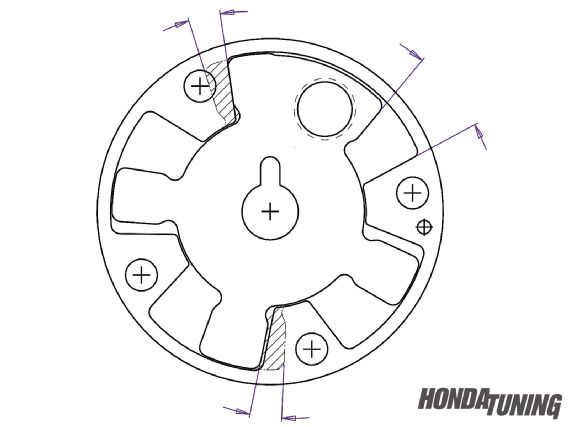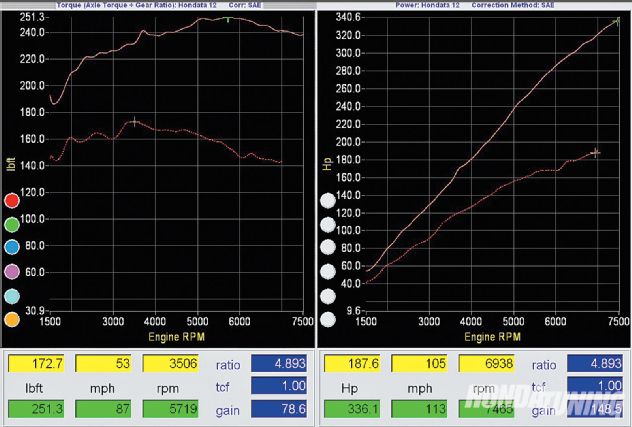 | Acura TSX Power Struggle
| Acura TSX Power Struggle
Doug MacMillan is the cofounder (with Derek Stevens) of Hondata, located in Torrance, California. Born in New Zealand and raised on a farm, if he wanted to drive a vehicle he usually had to fix it first. He holds an honor’s degree in physics and multiple world land speed records. In 2007, he piloted Hondata’s twin supercharged Acura RSX to a top speed of 234 mph and in 2009, won the SCTA points championship—proof indeed that Kiwis can fly.
 |
Acura TSX Power Struggle
|
Acura TSX Power Struggle
The release of the FlashPro for the 2004–2008 Acura TSX now means that the vast aftermarket range of K-series bolt-ons can be used to their full advantage. CT Engineering has made available, for a number of years, a low-boost supercharger kit for the ’04–’06 TSX. With the introduction of the FlashPro, the CT supercharger kit can now be fitted to the ’07–’08 TSX, and higher levels of boost can be realized. This article explores the improvements that can be made to the already impressive CT supercharger kit.
Test vehicle specs
’04 Acura TSX (MT)
’07 TSX ECU with ’04–’06 adapter kit
64mm ’06 TSX throttle body
Hondata FlashPro
45-degree VTC wheel
’06–’08 TSX intake cam
Hytech header and exhaust system with high-flow cat
CT Supercharger
3.1-inch pulley
The ’05–’06 TSX engine improvements
Let’s start by looking at the improvements Honda made from the ’05 to the ’06 model year. If you are contemplating a used TSX, or perhaps an engine swap, the ’06–’08 is what you should be after, and here’s why:
 |
Research and testing never really stops for the Hondata group. Constant tinkering and data gathering helps to produce a better end product for an ever-growing, loyal customer base
|
Research and testing never really stops for the Hondata group. Constant tinkering and data gathering helps to produce a better end product for an ever-growing, loyal customer base
Increased intake flow
Intake valve +1mm oversize
Intake cam high-lift lobe with 0.9mm more lift and 12 degrees more duration
Throttle body increased from 60 to 64mm
Radius on some intake pipes increased from 70 to 80mm
Increased exhaust flow
Exhaust head pipe increased from 60 to 65mm
Higher-flowing catalytic converter
Main (single) exhaust pipe increased from 54 to 57mm
Rear (twin) pipes increased in diameter from 42.5 to 45mm
Block improvements
Additional air passages in crankcase for reduced pumping losses
History
This particular TSX was used for naturally aspirated testing with Import Tuner (June ’12), and reached a peak number of 252hp, 204 lb-ft with stock injectors and a stock ’06–’08 TSX intake cam.
Injectors
At these boost power levels we are right on the limit of the 540cc CT injectors, so we switched to DeatchWerks 800cc injectors to provide more fuel for later upgrades.
Camshafts
The ’04–’08 TSX engines have great exhaust cams. The lift and duration for both low- and high-speed cams are larger than any other stock Honda camshaft. The ’06–’08 TSX engines also have great intake cams. The lift and duration for the low-speed cam betters any other Honda. The high-speed cam profile is from the DC5 Integra Type R. By comparison, the high-speed profile from the ’04–’05 TSX is the smallest high-speed lobe of any DOHC iVTEC K-series engine. So if you have a ’04–’05 TSX, a cam swap from the ’06–’08 TSX is a great bang for the buck. Just bolt it in and retune—no valvespring replacement is necessary. The Honda part number for this camshaft is 14110-RBB-A00 and retails for about $470.
VTC mechanism
The stock TSX VTC mechanism allows a maximum of 25 degrees cam advance, but the stock software limits that number to just 20 degrees. This is probably OK if your car is completely stock, but once you’ve added an intake, header, and exhaust, you can actually benefit from advancing and tuning your intake camshaft. If you are going to replace your intake camshaft, that’s the ideal time to bolt on a VTC mechanism with more cam advance. For my engine, I use a camshaft limited to a maximum of 45 degrees. Measurements on my engine show there shouldn’t be any valve-to-valve or valve-to-piston contact at 50 degrees advance. The reason for limiting the advance to 45 degrees rather than 50 is for an extra safety margin. The ’06–’08 TSX engines use a piston with slightly deeper valve cutout, and because of this, they carry slightly more clearance.
 |
A modified VTC mechanism can offer further tuning options for K24 owners. King Motorsports offers a replacement option with more cam advance, or the company can machine your stock unit.
|
A modified VTC mechanism can offer further tuning options for K24 owners. King Motorsports offers a replacement option with more cam advance, or the company can machine your stock unit.
By the time you’ve read this, King Motorsports will be offering a new custom modified VTC mechanism, or for a lower price, the company can machine your VTC mechanism for more advance. More information can be found on King Motorsports’ website.
Tuning for the CT Supercharger
Short intake runner manifolds like the CT and JR superchargers like a lot of cam advance. For the CT charger, I run 45 degrees advance from the VTEC point of 3,500 rpm to 7,000 rpm, retarding to 40 degrees at redline. As you tune the different cam angles and VTEC point, you may learn something counterintuitive; that less boost equals more power. At 3,500 rpm, when the cam switches, boost drops almost 2 psi. This is because the low-lift, short-duration, low-speed camshaft traps air in the intake manifold which forces up the boost pressure. When VTEC engages, the intake manifold rapidly depressurizes, a little like taking a cork out of a champagne bottle. This causes a momentary lean spike that is difficult to tune out. The engine responds beautifully to high-speed cam advance. This is because the earlier the cam is opened, the sooner the cylinder filling can begin. If you retard the high-speed cam to 0 degrees, for example, the boost will climb several psi and the power will drop 30 to 40hp.
 |
Doug MacMillan prepping the CT Engineering supercharger-equipped TSX for more dyno testing.
|
Doug MacMillan prepping the CT Engineering supercharger-equipped TSX for more dyno testing.
As a side note, the shorter the intake runner, the more cam advance is needed, especially at high rpm. At the end of the day, we have almost 150hp over stock, with a wide, strong, smooth torque curve. With over 210 lb-ft torque at 2,000 rpm, the car is a blast to drive.
Upgrade Recommendations
 |
Acura TSX Power Struggle
|
Acura TSX Power Struggle
At these high torque levels, a limited-slip differential is highly recommended to get you to speed with less drama. Bigger brakes would be a smart idea, to haul yourself down from those speeds you will be hitting.
What’s Next?
Two things come to mind: more boost and more octane. We’ll do a follow-up in a future issue of Honda Tuning. Stay tuned…
 | Acura TSX Power Struggle
| Acura TSX Power Struggle
 | Note the amount of torque being produced even at a very low 2,000 rpm. Just one of the many benefits to a properly tuned supercharger.
| Note the amount of torque being produced even at a very low 2,000 rpm. Just one of the many benefits to a properly tuned supercharger.
Editor’s Impression
When Doug called about the strides he’d been making with his supercharged TSX, I wasted no time in meeting up with him to see the car and the dyno results in person. After Doug finished some fine-tuning, he let me loose behind the wheel of his TSX. The car’s outward appearance is completely stock, other than a Hytech exhaust system. No flashy wheels or even a slight height adjustment, just a run-of-the-mill TSX. Rather than jumping on the road at full throttle and perhaps attracting unwanted attention to the dyno facility, I drove about four blocks south, from light to light, taking note of the car’s street-friendly nature. No hiccups, to twitchy throttle, in fact, if I hadn’t seen the car beforehand, I would’ve assumed it just had an exhaust system as I kept pedal pressure and revs at a very conservative point. Away from the dyno facility, on an open stretch of road that runs between Long Beach and Wilmington, I stomped the gas to get a feel for the car and its newfound power. Having driven a number of turbocharged Hondas before, I’d felt far more horsepower and torque, almost to the point of just being plain silly on a street car. However, the power delivery by the CT Engineering supercharger combined with Doug of Hondata’s tuning is a completely different animal. Power begins building almost immediately and climbs steadily to redline, never showing any signs of faltering. Cruising in third gear at about 2,500 rpm, I poked at the gas pedal momentarily and the car ripped forward, all but begging to have the gas pedal held down. Instantaneous torque is available in any gear at just about any speed.
On the freeway, downshifting is a thing of the past, as passing power is a night-and-day difference. When I did in fact feel the urge to downshift, the torque poured on immediately and I found myself “above the speed limit” by a pretty significant margin in quick order.
As I headed back to return the car, I pulled up to a light just a few blocks away from my destination. To my left sat a pair of California motorcycle officers. A friendly nod, and the one closest to me gave a short wave as the light turned green and they headed off. No drama involved—the car looks just like any other mundane sedan, although this one happens to be packing a viscous punch. —Rodrez
